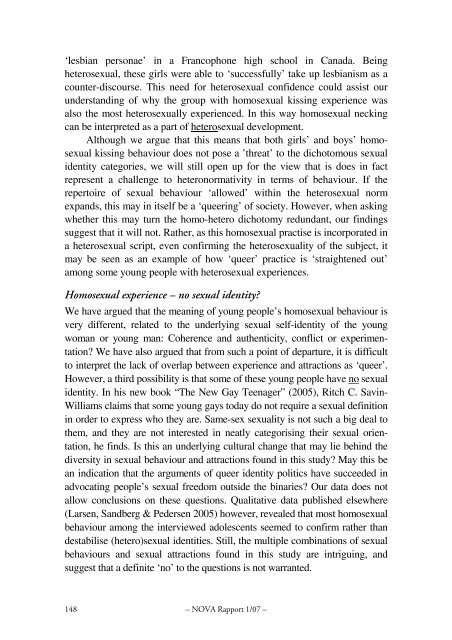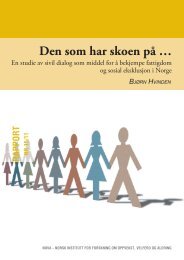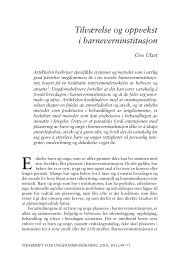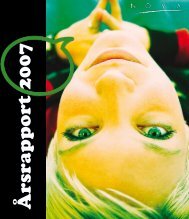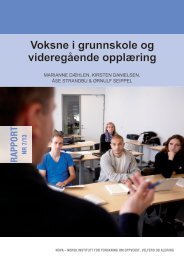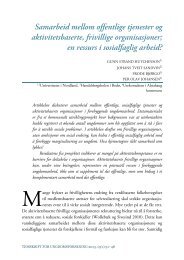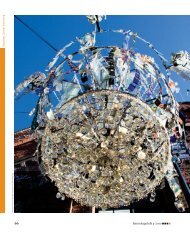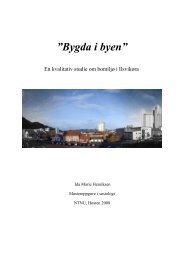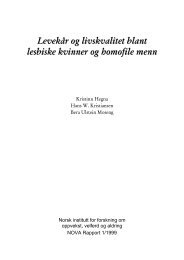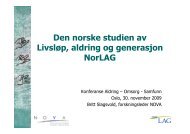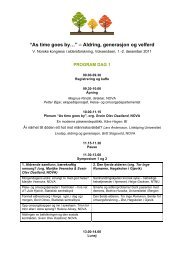Betydningen av seksuell erfaring, tiltrekning og identitet for ...
Betydningen av seksuell erfaring, tiltrekning og identitet for ...
Betydningen av seksuell erfaring, tiltrekning og identitet for ...
You also want an ePaper? Increase the reach of your titles
YUMPU automatically turns print PDFs into web optimized ePapers that Google loves.
‘lesbian personae’ in a Francophone high school in Canada. Being<br />
heterosexual, these girls were able to ‘successfully’ take up lesbianism as a<br />
counter-discourse. This need <strong>for</strong> heterosexual confidence could assist our<br />
understanding of why the group with homosexual kissing experience was<br />
also the most heterosexually experienced. In this way homosexual necking<br />
can be interpreted as a part of heterosexual development.<br />
Although we argue that this means that both girls’ and boys’ homosexual<br />
kissing beh<strong>av</strong>iour does not pose a ’threat’ to the dichotomous sexual<br />
identity categories, we will still open up <strong>for</strong> the view that is does in fact<br />
represent a challenge to heteronormativity in terms of beh<strong>av</strong>iour. If the<br />
repertoire of sexual beh<strong>av</strong>iour ‘allowed’ within the heterosexual norm<br />
expands, this may in itself be a ‘queering’ of society. However, when asking<br />
whether this may turn the homo-hetero dichotomy redundant, our findings<br />
suggest that it will not. Rather, as this homosexual practise is incorporated in<br />
a heterosexual script, even confirming the heterosexuality of the subject, it<br />
may be seen as an example of how ‘queer’ practice is ‘straightened out’<br />
among some young people with heterosexual experiences.<br />
Homosexual experience – no sexual identity?<br />
We h<strong>av</strong>e argued that the meaning of young people’s homosexual beh<strong>av</strong>iour is<br />
very different, related to the underlying sexual self-identity of the young<br />
woman or young man: Coherence and authenticity, conflict or experimentation?<br />
We h<strong>av</strong>e also argued that from such a point of departure, it is difficult<br />
to interpret the lack of overlap between experience and attractions as ‘queer’.<br />
However, a third possibility is that some of these young people h<strong>av</strong>e no sexual<br />
identity. In his new book “The New Gay Teenager” (2005), Ritch C. S<strong>av</strong>in-<br />
Williams claims that some young gays today do not require a sexual definition<br />
in order to express who they are. Same-sex sexuality is not such a big deal to<br />
them, and they are not interested in neatly categorising their sexual orientation,<br />
he finds. Is this an underlying cultural change that may lie behind the<br />
diversity in sexual beh<strong>av</strong>iour and attractions found in this study? May this be<br />
an indication that the arguments of queer identity politics h<strong>av</strong>e succeeded in<br />
advocating people’s sexual freedom outside the binaries? Our data does not<br />
allow conclusions on these questions. Qualitative data published elsewhere<br />
(Larsen, Sandberg & Pedersen 2005) however, revealed that most homosexual<br />
beh<strong>av</strong>iour among the interviewed adolescents seemed to confirm rather than<br />
destabilise (hetero)sexual identities. Still, the multiple combinations of sexual<br />
beh<strong>av</strong>iours and sexual attractions found in this study are intriguing, and<br />
suggest that a definite ‘no’ to the questions is not warranted.<br />
148<br />
– NOVA Rapport 1/07 –


